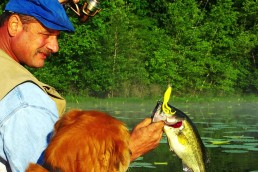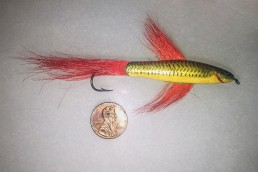How Does Your Favorite Lure Compare?
SHARE THIS POST
Someone asked me recently, “How do you determine that one lure is better than another?”
That’s a great question, but it’s not simple to answer.
Almost 40 years ago I started writing a weekly outdoor column. Like most everyone I started out with favorite ways to fish, but I still needed to learn more about every aspect. This made me a more devoted student—I’m naturally inquisitive anyway, always wanting to know how and why things work.
My press credentials have put me in close contact with a multitude of experts so I’ve always had excellent teachers. This made me sort of a jack-of-all-trades, but the versatility one gains through experience has been important as well. Guiding other fishermen for years also not only taught me a lot about the fickle fluctuations of fishing, but it also taught me about the differences in the way everyday anglers approach the sport, and has helped me develop an extensive method of testing baits.
First of all, I usually test a bait out for a year or more before I write anything about it. I’ve seen a lot of baits that will catch fish like crazy one day or week and then fizzle out. This is because there are times when bass, for instance, become so aggressive that they will hit just about anything. This is different, however, from the usual reason where a particular bait is hot for a year or so and then loses favor. Here, many people fish a hot bait and all species subsequently just become wise to it.
Some lures are seasonal, such as suspended jerkbaits. By the time I’ve determined a newer jerkbait is “good” the season is almost over so I’ll wait until the next season to reveal it. At any rate, some respectable period of productivity is necessary to make a lure worthy of print.
Are you enjoying this post?
You can be among the first to get the latest info on where to go, what to use and how to use it!
When really putting bait to the test I don’t just fish it to see if it will catch anything—everybody does that. Instead, I pit it against proven baits in the same waters at the same time, sometimes even alternating rods every cast. I try to use rods with a similar action, reels with the same retrieval rates, line with the same diameter, and so forth because all factors affect presentation. When I’m doing these tests I usually stay within the same lure types: spinnerbaits against other spinnerbaits, crankbaits against other crankbaits, jigs against other jigs, and so forth. Sometimes I can get a good fisherman to help me with this because switching rods every cast gets old. But I don’t trust those results as much as when I do it myself. I’ve seen too many times when two fishermen are fishing the same thing from the same boat and one will catch twice as many fish as the other. I’ve determined over the years that subtle differences in presentation are far more important than color or style of bait or numbers of fishermen in the boat.
As a general rule, most fishermen fish everything too fast. They troll too fast, cast to rapidly and retrieve too quickly. In the final analysis though, presentation is paramount. The biggest factor to a lure’s effectiveness lies in the hands, the attitude and the personality of the fisherman. That’s why nearly every bass angler has his own favorite way to fish or even a particular go-to bait they use most of the time.
What I’ve developed is as scientific and as objective as I can. But these methods are not foolproof; nothing catches fish all the time. There are, nonetheless, certain types of baits that have a design and action built into them that makes them “productive” within a wide range of presentations in a multitude of hands. These are the ones I like to write about most because the whole idea of doing this in the first place is to help other people have fun on the water.
As my old friend Wade Bourne said when accepting his induction into the Legends of the Outdoors Hall Of Fame: “I’ve got the greatest job in the world. I’m in the business of selling fun.”
When I’m testing and when I’m writing, I have the average guy in mind—the one who is used to coming fishing with me, isn’t afraid to ask questions and the kind who still gets that excitement you can see in their eyes when they catch a fish.
MWO
SHARE THIS POST
Did you enjoy this post?
You can be among the first to get the latest info on where to go, what to use and how to use it!
Ron Kruger
Ron Kruger has been communicating the outdoor experience for more than four decades. He has worked as a full-time guide for trout on the North Fork, for crappies and bass on Kentucky Lake and for smallmouths on the Current River. He has served as editor of three outdoor magazines, and owns a patent on a fly/lure called the Desperate Diver.



